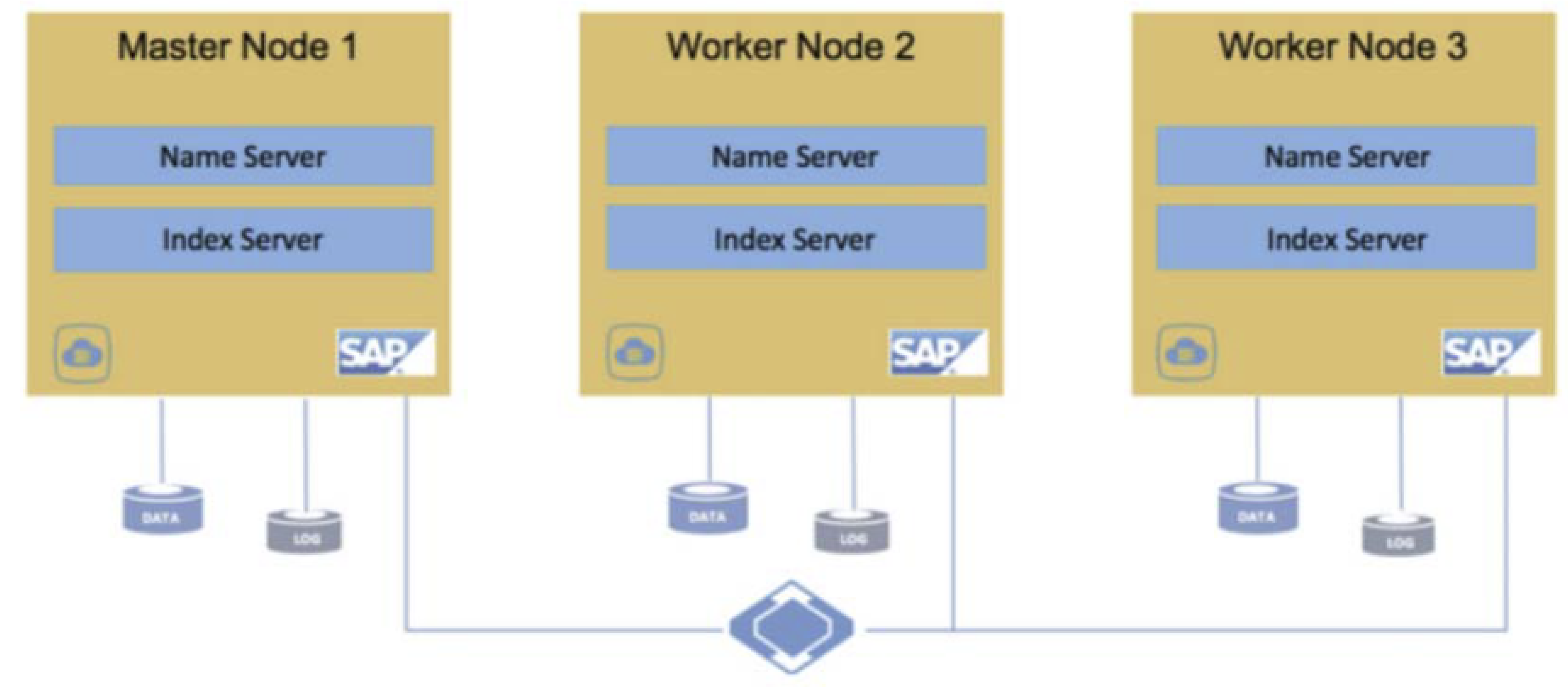Esta página incluye información sobre la protección de HANA 1+n y el escalado horizontal de HANA.
Protección de HANA 1+n
Para proteger un clúster de replicación de HANA 1+n como una sola aplicación, la aplicación tiene el host del clúster como sid name_cluster después de la detección de la aplicación. Por ejemplo, si sr1 es la instancia de HANA, el nombre de la aplicación es sr1 y el nombre de host es sr1_cluster en la lista Aplicaciones del Gestor de aplicaciones.
El destino de la copia de seguridad de los registros de HANA debe compartirse entre dos nodos. Cuando se produce una conmutación por error, la base de datos y la copia de seguridad de los registros se conmutan automáticamente a la principal actual, y las copias de seguridad de los registros se realizan desde la principal actual, lo que permite capturar los últimos registros de la principal anterior, así como los nuevos registros de la principal actual. Sigue los pasos de preparación que se indican en el artículo Preparar las bases de datos SAP HANA para la protección.
HANA 1+n siempre se detecta como una aplicación de clúster que contiene todos los detalles de los nodos en los metadatos. Es recomendable ejecutar una detección forzada después de hacer cambios en la configuración de los nodos del clúster, como añadir o eliminar un nodo del clúster. Si se añade o se elimina un nodo después de la detección y la protección, la configuración no se actualizará automáticamente en los metadatos de Backup and DR, lo que puede provocar problemas con las copias de seguridad.
Requisitos previos para proteger instancias y bases de datos de SAP HANA 1+n
Antes de proteger las instancias de SAP HANA, asegúrate de que se cumplen los siguientes requisitos:
- Si los hosts tienen IPs virtuales configuradas, añade solo la IP virtual y el nombre de host del host principal durante la detección.
- El agente de Backup and DR debe instalarse en todos los nodos.
- Los puertos deben abrirse en los hosts para permitir la comunicación en el puerto 5106. Para ello, se necesita una regla de cortafuegos de entrada en la que el dispositivo de copia de seguridad o recuperación sea el origen, el host que ejecuta el agente sea el destino y el puerto de destino sea 5106. Además, no es necesario añadir el puerto 5106 a la regla de entrada predeterminada creada para el dispositivo, ya que esta especifica el dispositivo como destino.
- La ubicación de la copia de seguridad de los registros de HANA debe definirse en NFS compartido.
Proteger la escalabilidad horizontal de HANA

Requisitos previos para proteger instancias de escalado horizontal de SAP HANA
Antes de proteger las instancias de escalado horizontal de SAP HANA, asegúrate de que se han completado los siguientes pasos:
- Si los hosts tienen IPs virtuales configuradas, añade solo la IP virtual y el nombre de host asociado del host principal durante la detección.
- El agente de Backup and DR debe instalarse en todos los nodos.
- Los puertos deben abrirse en los hosts para permitir la comunicación en el puerto 5106. Para ello, se necesita una regla de cortafuegos de entrada en la que el dispositivo de copia de seguridad o recuperación sea el origen, el host que ejecuta el agente sea el destino y el puerto de destino sea 5106. Además, no es necesario añadir el puerto 5106 a la regla de entrada predeterminada creada para el dispositivo, ya que esta especifica el dispositivo como destino.
- Para la copia de seguridad completa e incremental basada en archivos de Backint, la ubicación de la copia de seguridad del registro de HANA debe configurarse como compartida (NFS). Consulta Añadir el host a la consola de administración.
Para la protección de instantáneas de almacenamiento
- El volumen de datos y registros no se comparte entre todos los nodos
- El gestor de volúmenes lógicos (LVM) gestiona los volúmenes de datos y de registros.
- Asegúrate de que los directorios mnt000* existen en los puntos de montaje locales para identificar los nodos principal y secundario.
Sigue los procedimientos de configuración que se indican en el artículo Preparar las bases de datos de SAP HANA para la protección.
Documentación del servicio de copias de seguridad y recuperación ante desastres para el escalado horizontal de SAP HANA
Esta página forma parte de una serie de páginas específicas sobre la protección y recuperación de instancias de escalado horizontal de SAP HANA con el servicio Backup y DR. Puedes consultar más información en las siguientes páginas:
- Copia de seguridad y recuperación ante desastres para escalado horizontal de SAP HANA
- Preparar instancias de escalado horizontal de SAP HANA para la copia de seguridad
- Añadir un host de escalado horizontal de SAP HANA, y descubrir y proteger sus bases de datos
- Configurar el formato del disco de almacenamiento temporal y el método de copia de seguridad para el escalado horizontal de SAP HANA
- Definir los detalles y la configuración de las aplicaciones para las instancias de escalado horizontal de SAP HANA
- Crear copias de seguridad de bases de datos HANA 1+n y de escalabilidad horizontal de HANA
- Restaurar y recuperar instancias de escalado horizontal de SAP HANA
- Montar una copia de seguridad de escalabilidad horizontal de SAP HANA como un montaje estándar
- Montar una copia de seguridad de escalado horizontal de SAP HANA como base de datos virtual
- Montar y migrar una copia de seguridad de escalado horizontal de SAP HANA para realizar una recuperación instantánea en cualquier destino

